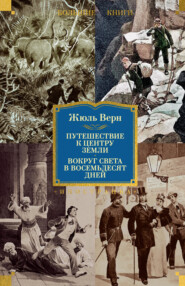По всем вопросам обращайтесь на: info@litportal.ru
(©) 2003-2024.
✖
Celebrated Travels and Travellers, Part 3. The Great Explorers of the Nineteenth Century
Настройки чтения
Размер шрифта
Высота строк
Поля
At last the caravan entered the fertile district of Tak or El Gasch, a wide watered plain, whose soil is wonderfully fertile, but which for two months in the year is uninhabited. Grain is plentiful and is sold in Jeddah for twenty per cent. more than the best Egyptian millet.
The inhabitants, who are called Hadendoa, are treacherous, dishonest, and bloodthirsty; and their women are almost as degraded as those of Shendy and Berber.
Upon leaving Taka, the road to Suakin and the shores of the Red Sea lay over a chain of chalk hills. At Schenterab granite is found. The hills presented few difficulties, and the caravan reached Suakin in safety upon the 26th May. But Burckhardt's troubles were not yet at an end. The Emir and Aga combined to plunder him, and treated him as the lowest of slaves, until he produced the firman which he had received from Mehemet Ali and Ibrahim Pasha. This changed the face of affairs. Instead of being thrown into prison the traveller was invited to the Aga's, who offered him a present of a young slave. M. Vivien de Saint Martin writes of this expedition, "This journey of from twenty to twenty-five days, between the Nile and the Red Sea, was the first ever undertaken by a European. The observations collected, as to the settled or nomad tribes of these districts are invaluable for Europe. Burckhardt's narrative is of increasing interest, and few can compare with it for instruction and interest."
Upon the 7th of July Burckhardt succeeded in embarking in a boat, and eleven days later he reached Jeddah, which serves as a harbour to Mecca. Jeddah is built upon the sea-shore, and is surrounded by a wall, which, insufficient as it would be against artillery, protects it perfectly from the attacks of the Wahabees, who have been nicknamed the "Puritans of Islamism." These people are a distinct sect, who claim to restore Mahomedanism to its primitive simplicity.
"The entrance to the town, upon the side nearest the sea," says Burckhardt, "is protected by a battery which overlooks the entire fort, and is surmounted by one enormous piece of artillery capable of discharging a five-hundred pound shot, which is so renowned throughout the Arabian Gulf, that its reputation alone is enough to protect Jeddah."
The greatest drawback to this city is its want of fresh water, which is brought from small wells two miles distant. Without gardens, vegetables, or date-trees, Jeddah, in spite of its population of twelve or fifteen thousand (a number which is doubled in the pilgrimage season) presents a strange appearance. The population is the reverse of autochthonous; it is composed of natives of Hadramaut and Yemen, Indians from Surat and Bombay, and Malays who come as pilgrims and settle in the town. Burckhardt introduces many anecdotes of interest into his account of the manners, mode of living, price of commodities, and number of traders in the place.
Speaking of the singular customs of the natives of Jeddah, he says: – "It is the almost universal custom for everybody to swallow a cup full of ghee or melted butter in the morning. After this they take coffee, which they regard as a strong tonic; and they are so accustomed to this habit from their earliest years, that they feel greatly inconvenienced if they discontinue it. The higher classes are satisfied with drinking the cup of butter, but the lower classes add another half cup, which they draw up through the nostrils, imagining that they thus prevent bad air entering the body by those apertures."
The traveller left Jeddah for Tayf on the 24th of August. The road winds over mountains and across valleys of romantic beauty and luxuriant verdure. Burckhardt was taken for an English spy at Tayf, and, although he was well received by the Pasha, he had no liberty, and could not carry on his observations.
Tayf, it appears, is famous for the beauty of its gardens; roses and grapes are sent from it into all the districts of Hedjaz. This town had a considerable trade, and was very prosperous before it was plundered by the Wahabees.
The surveillance to which he was subjected hastened Burckhardt's departure, and upon the 7th of September he started for Mecca. Well versed in the study of the Koran, and acquainted with all the practices of Islamism, he was prepared to act the part of a pilgrim. His first care was to dress himself in accordance with the law prescribed for the faithful who enter Mecca – in the "ihram," or pieces of cloth without seam, one covering the loins, the other thrown over the neck and shoulders. The pilgrim's first duty is to proceed to the temple, without waiting even to procure a lodging. This Burckhardt did not fail to do, observing at the same time the rites and ceremonies prescribed in such cases, of which he gives many interesting particulars; we cannot, however, dwell upon them here.
"Mecca," says Burckhardt, "may be called a pretty town. As a rule, the streets are wider than in most Eastern cities. The houses are lofty and built of stone; and its numerous windows, opening upon the street, give it a more cheerful and European aspect than the cities of Egypt or Syria, whose dwellings generally have few windows on the outside. Every house has a terrace built of stone, and sloping in such a way as to allow water to run down the gutters into the street. Low walls with parapets conceal these terraces; for, as everywhere else in the East, it is not thought right for a man to appear there; he would be accused of spying upon the women, who spend much of their time upon the terrace of the house, engaged in domestic work, drying corn, hanging out linen, &c."
The only public place in the city is the large court of the Grand Mosque. Trees are rare; not a garden enlivens the view, and the scene depends for animation upon the well-stocked shops which abound during the pilgrimage. With the exception of four or five large houses belonging to the administration, two colleges, which have since been converted into warehouses for corn, and the mosque with the few buildings and colleges connected with it, Mecca can boast of no public buildings, and cannot compete in this respect with other cities in the East of the same size.
The streets are unpaved; and as drains are unknown, water collects in puddles, and the accumulation of mud is inconceivable. For a water supply the natives trust to heaven, catching the rain in cisterns, for that obtained from the wells is so foul that it is impossible to drink it.
In the centre of the town, where the valley widens a little, the mosque known as Beithóu'llah, or El Haram, is situated. This edifice owes its fame to the Kaaba which is enclosed in it, for other Eastern towns can boast of mosques equally large and more beautiful. El Haram is situated in an oblong space, surrounded on the eastern side by a quadruple colonnade, and by a triple one on the other. The columns are connected by pointed arches, upon each four stand little domes constructed of mortar and whitened outside. Some of these columns are of white marble, granite, or porphyry, but the greater part are of the common stone found among the mountains of Mecca.
The Kaaba has been so often ruined and restored that no trace of a remote antiquity remains. It was in existence before this mosque was built.
The traveller says, "The Kaaba is placed upon an inclined base some two feet high, and its roof being flat, it presents the appearance at a little distance of a perfect cube. The only door by which it can be entered, and which is opened two or three times a year, is on the north side, about seven feet above the ground, for which reason one cannot enter except by means of a wooden staircase. The famous 'black stone' is enshrined at the north-eastern corner of the Kaaba, near the door, and forms one of the angles of the building four or five feet above the floor of the court. It is difficult to ascertain the exact nature of this stone, as its surface has been completely worn and reduced to its present condition by the kisses and worshipping touches bestowed upon it by countless millions of pilgrims. The Kaaba is entirely covered with black silk, which envelopes its sides, leaving the roof exposed. This veil or curtain is called 'the Kesoua,' and is renewed yearly during the pilgrimage. It is brought from Cairo, where it is manufactured at the expense of the Viceroy."
Up to the time of Burckhardt no such detailed account of Mecca and her sanctuary had been given to the world. For this reason we shall insert extracts from the original narrative; extracts which might indeed be multiplied, for they include circumstantial accounts of the sacred well, called Zemzem, water from which is considered as an infallible remedy for every complaint. The traveller speaks also of the "Gate of Salvation," of the Makam Ibrahim, a monument containing the stone upon which Abraham sat when he was engaged in building the Kaaba, and where the marks of his knees may still be seen, and of all the buildings enclosed within the temple precincts.
Judging from Burckhardt's minute and complete description, these spots still retain their former physiognomy. The same number of pilgrims chant the same songs; the men only are no longer the same. His accounts of the feast of the pilgrimage and the holy enthusiasm of the faithful, are followed by a picture which brings before us, in the most sombre colours, the effects of this great gathering of men, attracted from every part of the world.
"The termination of the pilgrimage," he says, "lends a very different aspect to the mosque. Illness and death, consequent upon the great fatigues undergone during the voyage, are accelerated by the scanty covering afforded by the Ihram, the unhealthy dwellings of Mecca, the bad food, and frequent absolute dearth of provisions. The temple is filled with corpses brought thither to receive the prayers of the Iman, or with sick persons who insist upon being carried, as their last hours approach, to the colonnade, hoping to be saved by the sight of the Kaaba, or in any case to have the consolation of expiring within the sacred precincts. One sees poor pilgrims, sinking under illness and hunger, dragging their weary bodies along the colonnade; and when they no longer have the strength to stretch out a hand to the passer-by, they place a little jar beside the mat upon which they are laid, to receive what charity may bestow upon them. As they feel the last moment approach, they cover themselves with their ragged clothes, and very often a day passes before it is ascertained that they are dead."
We will conclude our extracts from Burckhardt's account of Mecca with his opinion of the inhabitants.
"Although the natives of Mecca possess grand qualities, although they are pleasant, hospitable, cheerful and proud, they openly transgress the Koran by drinking, gambling, and smoking. Deceit and perjury are no longer looked upon as crimes by them; they do not ignore the scandal such vices bring upon them; but while each individually exclaims against the corruption of manners, none reform themselves."
Upon the 15th of January, 1815, Burckhardt left Mecca with a caravan of pilgrims on their way to visit the tomb of the prophet. The journey to Medina, like that between Mecca and Jeddah, was accomplished at night, and afforded little opportunity for observation. In the winter night-travelling is less comfortable than travelling by day. A valley called Wady-Fatme, but generally known as El-Wadi, was crossed; it abounded in shrubs and date-trees, and was well cultivated in the eastern portion. A little beyond it lies the valley of Es-Ssafra, the market of the neighbouring tribes and celebrated for its plantations of dates.
The traveller relates that "The groves of date-trees extend for nearly four miles, and belong to the natives of Ssafra as well as to the Bedouins of the neighbourhood, who employ labourers to water the ground, and come themselves to reap the harvest. The date-trees pass from one person to another in the course of trade; they are sold separately. A father often receives three date-trees as the price of the daughter he gives in marriage. They are all planted in deep sand brought from the middle of the valley, and piled up over their roots; they ought to be renewed every year, and they are generally swept away by the torrents. Each little plot is surrounded by a wall of mud or stone, and the cultivators live in hamlets or isolated cabins among the trees. The principal stream flows through a grove near the market; beside it rises a little mosque, shaded by large chestnuts. I had seen none before in the Hedjaz."
Burckhardt was thirteen days in reaching Medina. But this rather long journey was not lost time to him; he collected much information about the Arabs and the Wahabees. At Medina, as at Mecca, the pilgrim's first duty is to visit the tomb and mosque of Mahomet; but the ceremonies attending the visit are much easier and shorter, and the traveller performed them in a quarter of an hour.
Burckhardt's stay at Mecca had already been prejudicial to him. At Medina he was attacked by intermittent fever, which increased in violence, and was accompanied by violent sickness. This soon so reduced him, that he could no longer rise from his carpet without the assistance of his slave, "a poor fellow who by nature and habit was more fit to tend camels than to take care of his worn-out and enfeebled master."
Burckhardt being detained at Medina for more than three months by a fever, due to bad climate, the detestable quality of the water, and the prevalence of infectious illnesses, was forced to relinquish his project of crossing the desert to Akabah, in order to reach Yanibo as quickly as possible, and from thence embark for Egypt.
"Next to Aleppo," he says, "Medina is the best-built town I have seen in the East. It is entirely of stone, the houses being generally three stories high, with flat tops. As they are not whitewashed, and the stone is brown in colour, the streets, which are very narrow, have usually a sombre appearance. They are often only two or three paces wide. At the present time Medina looks desolate enough; the houses are falling into ruins. Their owners, who formerly derived a considerable profit from the inroad of pilgrims, find their revenues diminishing, as the Wahabees forbid visitors to the tomb of the prophet, alleging that he was but a mere mortal. The possession which places Medina on a par with Mecca is the Grand Mosque, containing the tomb of Mahomet. This is smaller than that at Mecca, but is built upon the same plan, in a large square courtyard, surrounded on all sides by covered galleries, and having a small building in the centre. The famous tomb, surrounded by an iron railing painted green, is near the eastern corner. It is of good workmanship, in imitation of filagree, and interlaced with inscriptions in copper. Four doors, of which three lead into this enclosure, are kept constantly shut. Permission to enter is freely accorded to persons of rank, and others can purchase permission of the principal eunuchs for about fifteen piasters. In the interior are hangings which surround the tomb, and are only a few feet from it." According to the historian of Medina, these hangings cover a square edifice, built of black stones, and supported upon two columns, in the interior of which are the sepulchres of Mahomet and his two eldest disciples, Abou-Bekr and Omar. He also states that these sepulchres are deep holes, and that the coffin which contains the ashes of Mahomet is covered with silver, and surmounted by a marble slab with the inscription, "In the name of God, give him thy pity." The fables which were spread throughout Europe as to the tomb of the prophet being suspended in mid air, are unknown in the Hedjaz. The mosque was robbed of a great part of its treasures by the Wahabees, but there is some ground for believing that they had been forestalled by the successive guardians of the tomb.
Many other interesting details of Medina, and its inhabitants, surroundings, and the haunts of pilgrims, are to be found in Burckhardt's narrative. But we have given sufficient extracts to induce the reader who desires further information respecting the manners and customs of the Arabs, which have not changed, to refer to the book itself.
Upon the 21st of April, 1815, Burckhardt joined a caravan which conducted him to Yembo, where the plague was raging. The traveller at once fell ill and became so weak that it was impossible for him to resort to a country place. To embark was equally impossible; all the vessels which were ready to start were crowded with soldiers. He was compelled to remain eighteen days in the unhealthy little town, before he could obtain a passage in a small vessel which took him to Cosseir, and thence to Egypt.
Upon his return to Cairo Burckhardt heard of his father's death. The traveller's constitution had been sorely tried by illness, and he was unable to attempt the ascent of Mount Sinai until 1816. The study of natural history, the publication of his diary, and his correspondence, occupied him until 1817, at which time he expected to go with a caravan to Fezzan. Unfortunately he succumbed to a sudden attack of fever, his last words being, "Write and tell my mother that my last thought was of her."
Burckhardt was an accomplished traveller; well-informed, exact to minuteness, patient, courageous, and endowed with an upright and energetic character. His writings are of great value; the narrative of his voyage in Arabia – of which he unfortunately could not explore the interior – is so complete and precise, that owing to it that country was then better known than many in Europe.
In writing to his father from Cairo on the 13th of March, 1817, he says, "I have never said a word about what I have seen and met with that my conscience did not entirely justify; I did not expose myself to so much danger in order to write a romance!"
The explorers who have succeeded him in the same countries unanimously testify to his exactness, and agree in praising his fidelity, knowledge, and sagacity.
"Few travellers," says the Revue Germanique, "have enjoyed in a like degree the faculty of observation. That is a rare gift of nature, like all eminent qualities. He possessed a sort of intuition which discerned the truth, apart from his own observations, and thus information given by him from hearsay has a value that seldom attaches to statements of that nature. His mind, early ripened by reflection and study (he was but in his thirty-third year at the time of his death), invariably went straight to the point. His narrative, always sober, is filled – one may say – rather with things than words; yet his narratives possess infinite charm; one admires the man in them as much as the savant and observer."
While the Biblical countries occupied the attention of Seetzen and Burckhardt, India, the birthplace of most of the European languages, was about to command the attention of students of language, literature, and religion, as well as of geography. For the present our concern is with those problems of physical geography, which the conquests and studies of the India Company were about to solve by degrees.
In a preceding volume we have related how the Portuguese rule was established in India. The union of Portugal with Spain, in 1599, led to the fall of the Portuguese colonies, which came into the possession of the English and Dutch. England soon afterwards granted a monopoly of the commerce of India to a Company which was destined to play an important part in history.
At this time Akbar, the great Mogul emperor, the seventh descendant of Timour Leng, had established a vast empire in Hindustan and Bengal, upon the ruins of the Rajpoot kingdoms. Owing to the personal qualities of Akbar, which had gained for him the surname of the Benefactor of Man, that empire was at the height of its glory. The same brilliant course was pursued by Shah Jehan; but Akbar's grandson, Aurung Zeb, inspired by an insatiable ambition, assassinated his brothers, imprisoned his father, and seized the reins of government. While the Mogul Empire was in the enjoyment of profound peace, a clever adventurer laid the foundations of the Mahratta Empire. The religious intolerance of Aurung Zeb, and his crafty policy, led to the insurrection of the Rajpoots, and a struggle, which by draining the resources of the empire, shook his power. The death of the great usurper was followed by the decadence of the empire.
Up to this period the India Company had been unable to add to the narrow strip of territory which they possessed at the ports, but it was now to benefit by the conflict between the nabobs and rajahs of Hindustan. It was not, however, until after the taking of Madras, in 1746, by La Bourdonnais, and the struggle against Dupleix, that the influence and dominion of the English Company was materially increased.
The crafty policy of Clive and Hastings, the English Governors, who successively employed force, stratagem, and bribery, to attain their ends, laid the foundation of British greatness in India, and, at the close of the last century, the Company were possessors of an immense extent of country, with no less than sixty millions of inhabitants. Their territory included Bengal, Behar, the provinces of Benares, Madras, and the Sircars. Tippoo Saib alone, the Sultan of Mysore, struggled against the English encroachments, but he was unable to hold out against the coalition formed against him by the skill of Colonel Wellesley. When rid of their formidable enemies, the Company overcame such opposition as remained by pensions; and, under the pretext of protection, imposed upon the rajahs an English garrison which was maintained at their expense.
One would imagine from all this that the English rule was detested; but that is not the case. The Company, recognizing the rights of individuals, did not attempt to change the religion, laws, or customs of their subjects. Neither is it surprising that travellers, even when they ventured into districts which, properly speaking, did not belong to Great Britain, incurred but little danger. In fact, so soon as the East India Company was free from political embarrassments, it encouraged explorers throughout its vast domains. At the same time travellers were despatched to the neighbouring territories to collect observations, and we propose rapidly to review those expeditions.
One of the first and most curious was that of Webb to the sources of the Ganges, a river concerning which uncertain and contradictory opinions prevailed. The Government of Bengal, recognizing the great importance of the Ganges in the interests of commerce, organized an expedition, of which Messrs. Webb, Roper, and Hearsay, formed part. They were to be accompanied by Sepoys, native servants, and interpreters.
The expedition reached Herdouar, a small village on the left of the river, upon the 1st of April, 1808. The situation of this village, at the entrance of the fertile plains of Hindustan, had caused it to be much frequented by pilgrims, and it was at this spot that purifications in the waters of the holy river took place during the hot season.
As every pilgrimage implies the sale of relics, Herdouar was the centre of an important market, where horses, camels, antimony, asafoetida, dried fruits, shawls, arrows, muslins, cotton and woollen goods from the Punjab, Cabulistan, and Cashmere, were to be had. Slaves, too, were to be bought there from three to thirty years of age, at prices varying from 10 to 150 rupees. This fair, where such different races, languages, and costumes were to be met with, presented a curious spectacle.
Upon the 12th of April the English expedition set out for Gangautri, following a road planted with white mulberries and figs, as far as Gourondar. A little farther on water-mills of simple construction were at work, upon the banks of streams shaded with willows and raspberry-trees. The soil was fertile, but the tyranny of the Government prevented the natives from making the best of it.
The route soon became mountainous, but peach, apricot, nut, and other European trees abounded, and at length the expedition found themselves in the midst of a chain of mountains, which appeared to belong to the Himalaya range.
The Baghirati, which is known further on as the Ganges, was met with at the end of a pass. To the left, the river is bounded by high, almost barren mountains; to the right stretches a fertile valley. At the village of Tchiavli, the poppy is largely cultivated for the preparation of opium; here, owing probably, to the bad quality of the water, all the peasants suffer from wens.
At Djosvara the travellers had to cross a bridge of rope, called a "djorila." This was a strange and perilous structure.
"On either side of the river," says Webb, "two strong poles are driven in, at a distance of two feet from each other, and across them is placed another piece of wood. To this is attached a dozen or more thick ropes, which are held down upon the ground by large heaps of wood. They are divided into two packets, about a foot apart; Blow hangs a ladder of rope knotted to one of these, which answers instead of a parapet. The flooring of the bridge is composed of small branches of trees, placed at intervals of two and a half, or three feet from each other. As these are generally slender, they seem as if they were on the point of breaking every moment, which naturally induces the traveller to depend upon the support of the ropes which form the parapet, and to keep them constantly under their arms. The first step taken upon so shaky a structure is sufficient to cause giddiness, for the action of walking makes it swing to either side, and the noise of the torrent over which it is suspended is not reassuring. Moreover the bridge is so narrow, that if two persons meet upon it, one must draw completely to the side to make room for the other."
The expedition afterwards passed through the town of Baharat, where but few of the houses have been rebuilt since the earthquake of 1803. This locality has always enjoyed a certain importance from the fact that a market is held there, and also on account of the difficulty of obtaining provisions in the towns higher up, as well as from its central position. The routes to Jemauhi, Kedar, Nath, and Sirinagur all meet there.
Beyond Batheri the road became so bad that the travellers were obliged to abandon their baggage. There was a mere path-track by the edge of precipices, amid débris of stones and rocks; and the attempt to proceed was soon relinquished.

















